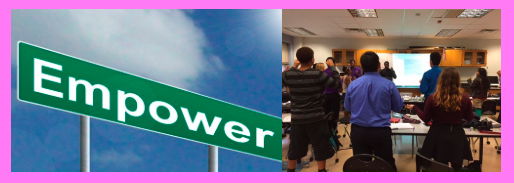

Develop Classroom Management Routines That Contribute to Success:
- co-develop a system with routines that train students to self-manage themselves
- General Strategies:
- Have clear vision of outcomes of classroom management
- Establish high expectations for smooth operation of classroom routines
- Study routines to make sure they work
- Have students reflect on routines and roles
- Enlist students in facilitating routines whenever possible
- Ensure that all students are involved in making the classroom culture work
Help Students Become Effective Partners in Their Own Success
- Help students recognize their strengths, interests and challenges
- Help students set and reach goals that take into account their interests, strengths and challenges
- General Strategies:
- Help students understand and see the benefits in their differences.
- Nurture awareness of students’ strengths and the benefits of enhancing these.
- Help students understand their weakness and how to remediate them.
- Guide students in vocabulary related to metacognition and goal setting.
- Ask students to reflect on their own growth and brainstorm next steps related to growth. For more ideas, see this article on the power of mistakes and struggle.
- Support students in setting and achieving personal goals.
Develop Flexible Classroom Teaching Routines:
- Play with classroom logistics in order to enhance learning
- General Strategies:
- Allow for students’ different pacings
- Gather basic and supplementary materials that appeal to students varied interests, cultures, lexile levels, etc.
- Teach in a variety of ways
- Ensure that grades reflect Growth as well as relative standing in the class
Expand a Repertoire of Instructional Strategies
- Use multiple modes to teach content
- General Strategies:
- Use variety of strategies for teaching content and managing student work time
- Use strategy that connect to students’ learning modes, interests, and readiness levels
- Guide students to work with instructional approaches appropriately
- Help students reflect on what strategies work for them and why
Reflect on Individual Progress with an Eye toward Curricular Goals & Personal Growth
- Measure and reflect on student progress towards learning targets
- General Strategies:
- Use pre-assessments to help prepare common and individualized learning tasks
- Use ongoing formative assessment to ensure as close a match as possible between learning activities and student needs
- Track student growth relative to learning targets
- Engage students in setting academic goals and achieving these
- Reflect on individual and group growth in order to improve instruction
- Help parents understand students’ growth relative to curricular goals
For more essential skills and attitudes go to: 28: Responsive Teaching: Essential Skills & Attitudes 1 of 2

Co-developing classroom logistics with students can make them more aware of the rationale and benefits of these logistics. This process will also empower students to feel like their opinions are valued. Helping students set and achieve goals helps them become lifelong learners. Better student self knowledge helps them to make choices that improve their learning and increase their independence. Flexible classroom routines help different learners learn differently. Improving logistics can make it possible to teach in multiple modes simultaneously. Expanding strategy repertoires make it more likely to engage and reach all learners. Reflecting on individual growth will help teachers and students develop individual growth plans needed for growth.

Preparation Steps
- Research classroom routines and logistics that promote positive learning culture and allow for multiple modes of learning at one time.
- Define clear culture outcomes that will frame all classroom management norms and routines.
- Brainstorm norms and routines with students that can achieve clear culture goals. For examples of good norms, read this article.
- Research multiple activities that can address learning targets.
- Research and create goal setting lesson plans and goal setting tools for students.
- Develop prompts that get students to reflect on their progress towards goals and the strategies that they are using to make that progress
Early Implementation Steps
- Facilitate activities that let students co-develop classroom norms and routines that achieve clear culture outcomes
- Have students regularly set goals, reflect on their progress towards these goals, and brainstorm next steps
- Implement multiple modes of activities to teach learning targets
- Have students reflect on what types of activities help them learn best
Advanced Implementation Steps
- Teach students how to use the vocabulary of metacognition and goal setting to write reflections on their progress that can help them learn things that can improve their approaches to learning. To learn more about thes learning strategies, go here.
- Develop systems for keeping parents informed of individual students’ progress towards learning targets
- Allow students to choose form a menu of learning tasks to achieve learning targets and reflect on whether or not their choice helped them to meet the target. See differentiated curriculum charts.
- Develop systems that teach students how to track their progress toward learning targets over time
 .
.
